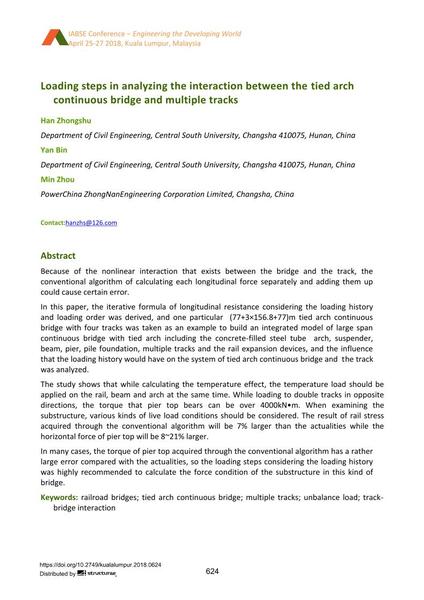Loading steps in analyzing the interaction between the tied arch continuous bridge and multiple tracks

|
|
|||||||||||
Bibliographic Details
| Author(s): |
Bin Yan
(Department of Civil Engineering, Central South University, Changsha 410075, Hunan, China)
Zhongshu Han (Department of Civil Engineering, Central South University, Changsha 410075, Hunan, China) Min Zhou (PowerChina ZhongNanEngineering Corporation Limited, Changsha, China) |
||||
|---|---|---|---|---|---|
| Medium: | conference paper | ||||
| Language(s): | English | ||||
| Conference: | IABSE Conference: Engineering the Developing World, Kuala Lumpur, Malaysia, 25-27 April 2018 | ||||
| Published in: | IABSE Conference Kuala Lumpur 2018 | ||||
|
|||||
| Page(s): | 624-631 | ||||
| Total no. of pages: | 8 | ||||
| DOI: | 10.2749/kualalumpur.2018.0624 | ||||
| Abstract: |
Because of the nonlinear interaction that exists between the bridge and the track, the conventional algorithm of calculating each longitudinal force separately and adding them up could cause certain error. In this paper, the iterative formula of longitudinal resistance considering the loading history and loading order was derived, and one particular (77+3×156.8+77)m tied arch continuous bridge with four tracks was taken as an example to build an integrated model of large span continuous bridge with tied arch including the concrete-filled steel tube arch, suspender, beam, pier, pile foundation, multiple tracks and the rail expansion devices, and the influence that the loading history would have on the system of tied arch continuous bridge and the track was analyzed. The study shows that while calculating the temperature effect, the temperature load should be applied on the rail, beam and arch at the same time. While loading to double tracks in opposite directions, the torque that pier top bears can be over 4000kN•m. When examining the substructure, various kinds of live load conditions should be considered. The result of rail stress acquired through the conventional algorithm will be 7% larger than the actualities while the horizontal force of pier top will be 8~21% larger. In many cases, the torque of pier top acquired through the conventional algorithm has a rather large error compared with the actualities, so the loading steps considering the loading history was highly recommended to calculate the force condition of the substructure in this kind of bridge. |
||||
| Keywords: |
railroad bridges rail bridges tied arch continuous bridge multiple tracks unbalance load track-bridge interaction
|
||||
